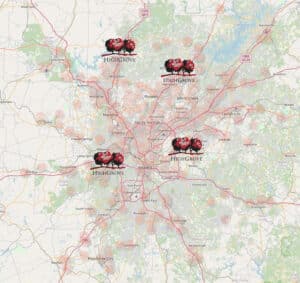If you manage properties in the Atlanta market, you may have noticed a push for existing buildings to become LEED certified.
What is a LEED Certification? According to USGBC, LEED (Leadership in Energy and Environmental Design) is the most widely used green building rating system globally. Available for virtually all building types, LEED provides a framework for healthy, highly efficient, and cost-saving green buildings.
There are several reasons to get your building LEED-Certified:
- It aligns with your ESG (environmental, social, and governance) goals
- Tenants are willing to pay higher rents for a “green lease.”
- Improvements will cut operational costs and increase efficiency
Getting your building certified under LEED for Existing Buildings and Operations and Maintenance (EBOM) is no simple task; it’s a commitment that involves capital improvements and a fundamental change in your daily operations.
It takes a minimum of 40 points to get your building certified under LEED EBOM — and your landscape contractor can help you achieve 15 of them.
Here’s a look at the LEED points landscapers can help you with — and some strategies to earn them.
SS Credit 2: Building Exterior and Hardscape Management Plan (1 Point)
You might already have this; consult with your landscaper to create a written plan of environmentally friendly ways to maintain your building’s exterior.
For example, you may specify the type of ice melt you use for snow and ice removal or chemicals you can use to clean your hardscapes.
SS Credit 3: Integrated Pest Management, Erosion Control and Landscape Management Plan (1 Point)
This credit is similar to SS Credit 2. You must have a written plan detailing your pest, site erosion, and landscape management. Include details of onsite green waste facilities or a reduced chemical approach to insects and weeds. (Warning: Sustainable landscape management can result in more weeds in your landscape.)
SS Credit 5: Site Development — Protect or Restore Open Habitat (1 Point)
Strategies to earn this credit include:
- Properly documenting your native or adaptive green space
- Converting sod and non-native plants to approved green space
- Replacing hardscapes with approved green space
- Setting aside green space offsite
SS Credit 6: Stormwater Quantity Control (1 Point)
Earn this credit by including any number of cisterns, bioswales, or other strategies to keep rainwater on your site. Water harvested by earning this credit can also be used for other points!
SS Credit 7.1: Heat Island Reduction — Nonroof (1 Point)
You have to decrease the heat your hardscapes and parking lot radiate back to earn this credit. A straightforward way to earn this credit is by planting trees on your lot!
SS Credit 7.2: Heat Island Reduction — Roof (1 Point)
This credit is similar to SS Credit 7.1, but you must reduce the heat radiated back from your roof. A great way to do this is by installing a green roof system or rooftop garden. But keep in mind that this can be a costly improvement — and not all buildings can support the additional weight.
WE Credit 1: Water Performance Measurement (1–2 points)
Meter your potable water use, both indoors and for irrigation. Earn two points by measuring multiple systems.
WE Credit 3: Water Efficient Landscaping (1–5 Points)
This credit aims to reduce the amount of potable and natural body water you use. Your goal with this point is to eliminate city water use and water sourced from wells and stream-fed ponds.
Strategies may include improved irrigation systems, cisterns, modifying your landscape to decrease water needs, and eliminating irrigation on established landscape material.
WE Credits 4.1–4.2: Cooling Tower Water Management (1-2 Points)
Install a cistern on your property and use the harvested water for your cooling tower to earn this credit.
IO Credit 2: LEED® Accredited Professional (1 Point)
Finally, you can earn a point just by having a LEED Accredited Professional on your team. The process takes about 25 days and will be a great asset for the team portfolio.
Ready to Get LEED Certified?
Hopefully, after reviewing the credits your landscaper can help you earn, you can take away some ideas to implement at your property. Of course, these strategies are just a brief list, and not every credit makes sense to pursue depending on cost and feasibility. The best thing to do is get your landscaper involved early on in the process, so they can help you identify which strategies are the best fit for you.




